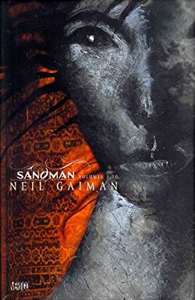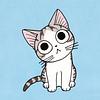Take a photo of a barcode or cover
The world of comic books was a very different place before the Sandman came into being. Neil Gaiman revolutionized the graphic novel with "The Sandman," an exquisite story filled with shadowy realistic art and strange magical beings. Bringing together the entire brilliant series, this collection is an essential read for fantasy and/or comic book fans.
A group of occultists once attempted to summon and trap Death... but instead, they capture Dream (aka Morpheus) and lock him in a glass orb. One day, Dream escapes his prison and reenters the world -- but soon discovers that the world of the Dreaming is in ruins, his creatures have escaped into the mortal world, and his magical items have been lost.
But restoring the Dreaming isn't his only problem. Morpheus also must deal with a dream vortex that now lives in the human world, the abandonment of Hell by Lucifer (and all the people who want it), and a woman locked in a strange dream world threatened by the Cuckoo. There are also tales of Dream and his family, the Endless, and their feuds, losses and quests -- such as when Dream is dragged off by his sister Delirium, in search of their long-lost brother Destruction.
There are also smaller stories, sometimes starring legendary figures like Augustus Caesar, Marco Polo, William Shakespeare, one of the Muses, and most notably Orpheus -- as well as tales of werewolves, faeries, ruined superheroes, cats and ordinary people.
The world of "The Sandman" is a strange one -- it lightly interlocks with other graphic novel series, effortlessly slips from one world to another, and exposes both the beauty and ugliness of our own world. It's a universe that is both strange and epic, but there are also a lot of layers that can terrify you.
And the artwork is sublime -- realistic in style, but often bizarre and a little frightening in theme. And despite the core colors being shadowy greys, whites and blacks, there are splashes of bright colors everywhere. Green fields, blue hallways, psychedelic skies, hallucinations filled with sickly pallid hues.
Gaiman created one of his most iconic, complex characters in Morpheus -- his inhumanity is reflected by acts of great cruelty and kindness. He starts off as a rather cold figure who does some rather nasty things, but he grows gradually over the course of the series, becoming a warmer, more compassionate creature. But Gaiman isn't afraid to occasionally poke fun at Morpheus' gloomy persona.
The author also spun up a very nonstereotypical version of Death. No robes, scythes or skeletal faces here. In fact, forget about anything sinister -- this version of Death is a delightfully quirky, perky goth chick. And she's only one of the dozens of memorable, fascinating and/or endearing characters who litter the pages -- from gods to animals, faeries to mortals.
But there is one way this could have been better: it does not contain "Dream Hunters" (either the novel or the graphic novel) and the follow-up collection "Endless Nights."
The complete Sandman series is a must-have for anyone who fancies themselves a reader -- especially if they have the guts to tackle a worlds-spanning epic, full of darkness and beauty. Do not miss Neil Gaiman's comic-book opus.
A group of occultists once attempted to summon and trap Death... but instead, they capture Dream (aka Morpheus) and lock him in a glass orb. One day, Dream escapes his prison and reenters the world -- but soon discovers that the world of the Dreaming is in ruins, his creatures have escaped into the mortal world, and his magical items have been lost.
But restoring the Dreaming isn't his only problem. Morpheus also must deal with a dream vortex that now lives in the human world, the abandonment of Hell by Lucifer (and all the people who want it), and a woman locked in a strange dream world threatened by the Cuckoo. There are also tales of Dream and his family, the Endless, and their feuds, losses and quests -- such as when Dream is dragged off by his sister Delirium, in search of their long-lost brother Destruction.
There are also smaller stories, sometimes starring legendary figures like Augustus Caesar, Marco Polo, William Shakespeare, one of the Muses, and most notably Orpheus -- as well as tales of werewolves, faeries, ruined superheroes, cats and ordinary people.
The world of "The Sandman" is a strange one -- it lightly interlocks with other graphic novel series, effortlessly slips from one world to another, and exposes both the beauty and ugliness of our own world. It's a universe that is both strange and epic, but there are also a lot of layers that can terrify you.
And the artwork is sublime -- realistic in style, but often bizarre and a little frightening in theme. And despite the core colors being shadowy greys, whites and blacks, there are splashes of bright colors everywhere. Green fields, blue hallways, psychedelic skies, hallucinations filled with sickly pallid hues.
Gaiman created one of his most iconic, complex characters in Morpheus -- his inhumanity is reflected by acts of great cruelty and kindness. He starts off as a rather cold figure who does some rather nasty things, but he grows gradually over the course of the series, becoming a warmer, more compassionate creature. But Gaiman isn't afraid to occasionally poke fun at Morpheus' gloomy persona.
The author also spun up a very nonstereotypical version of Death. No robes, scythes or skeletal faces here. In fact, forget about anything sinister -- this version of Death is a delightfully quirky, perky goth chick. And she's only one of the dozens of memorable, fascinating and/or endearing characters who litter the pages -- from gods to animals, faeries to mortals.
But there is one way this could have been better: it does not contain "Dream Hunters" (either the novel or the graphic novel) and the follow-up collection "Endless Nights."
The complete Sandman series is a must-have for anyone who fancies themselves a reader -- especially if they have the guts to tackle a worlds-spanning epic, full of darkness and beauty. Do not miss Neil Gaiman's comic-book opus.
adventurous
dark
emotional
mysterious
adventurous
challenging
dark
emotional
hopeful
mysterious
sad
tense
slow-paced
Strong character development:
Yes
Loveable characters:
Yes
Diverse cast of characters:
Yes
Flaws of characters a main focus:
Yes
challenging
mysterious
medium-paced
Strong character development:
No
Loveable characters:
Complicated
Diverse cast of characters:
Complicated
Flaws of characters a main focus:
Yes
I can appreciate that Gaiman's Sandman series did a lot to push boundaries in the 80s and 90s in comics, but in 2020? This isn't necessarily something I'd recommend to anyone who's not actively seeking out the stepping stones that got us to where we are. Yes, they're an important part of history, but I don't think they deserve the ongoing popularity and praise they keep receiving, because this series is far from progressive or imaginative by the standards of what's being done here and now.
adventurous
challenging
emotional
funny
hopeful
inspiring
mysterious
reflective
relaxing
sad
tense
Strong character development:
Yes
Loveable characters:
Yes
Diverse cast of characters:
Yes
Flaws of characters a main focus:
Yes
adventurous
dark
emotional
inspiring
mysterious
medium-paced
Strong character development:
Complicated
Loveable characters:
Yes
Diverse cast of characters:
No
Flaws of characters a main focus:
Yes





